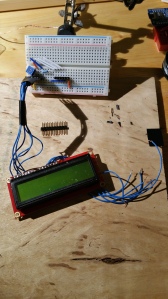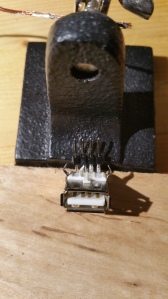I’ve made a couple of recent purchases after considering the full scope of my project.
Firstly I’ve bought another SparkFun 16×2 LCD module, and this time I won’t ruin it with a soldering iron by accident!!!
This LCD will be used in the D of E supervisor’s receiver module. I’ve also developed a user interface and set of menus so you can navigate through and track multiple teams, find your own position, edit settings, and even navigate to a selected team. (distance, bearing).
In order to drive this though I had to use some sort of interface. Several small buttons seemed a bit fiddly to add to the box, so I’ve opted for a PlayStation controller like Joystick! I can mount this on the project box next to the LCD. If you push this joystick down it also acts like a selection button, so I have left to right, and up to down navigation, and a selection button. Just like a standard modern GPS unit (but at a fraction of the cost).
Interestingly, SparkFun have stopped selling the black project box, now instead selling a clear one. That’s pretty awesome from a show-and-tell perspective! I can now show off the project, and see the power LEDs through the case. No need to drill LED holes that may leak in water.
I’ve also decided to buy a couple of micro SD interface cards – a ArduLogger device from a local supplier, but with the SparkFun OpenLogger software installed. This software is a bit more flexible, allowing you to name multiple files and either replace their content or append new content. Perfect for a receiver tracking multiple teams – you can have a GPX file for each day for each team. Great! I’ll also fit this on the transmitter so I can check the teams actual route later if they go out of signal line of sight. Not that I don’t trust them…
I also decided against bluetooth for a couple of reasons. Firstly, more complexity, space, and power usage for a very limited ‘download’ mode at the end of a walk. Also because I have a whopping 433MHz module already with a high baud rate! May as well re-use that to request and force an upload of an entire set of logs. They’re only a few KB for a day, so won’t take long at all to transmit.
Having two transceivers also brings the tantalising prospect of sending and receiving messages. A future ‘posh’ version of the transmitter may be a bigger battery, and LCD screen, and another joystick – so the team can send progress reports and receive information from their supervisors. E.g. ‘get off the mountain – crazy weather coming!’
I’ve also found a cheap supplier in Singapore for my Arduino Mega boards. More on that in another post. They’re approx GBP 1.80 each! Great if you want to make a lot of modules.
For my next trick I’ll use a Dremel to cut holes in my project case so I can mount the components. More to follow!…


Recent Comments